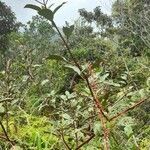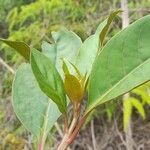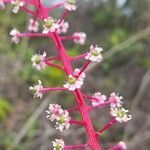Woody herb or subshrub to 3(-5) m tall. Stem ribbed, angled, glabrous. Leaves ovate, elliptical, lanceolate or oblong, to 21 x 8 cm, apex acute or acuminate, base acute or obtuse, glabrous, with pink-tinged veins, calcium oxalate raphides in epidermis visible with lens; petiole glabrous, 1-7 cm long. Inflorescence a many-flowered terminal or (pseudolateral) axillary raceme to 65(-70) cm long, to ca. 4 cm wide, simple (or rarely with 1-2 long branches from near base), much longer than leaves, rachis turning bright purple, glabrous; flowers widely spaced; bracts subtending pedicel linear, lance-linear or lanceolate, 1.5-5 mm long, hyaline; bracteoles 1-2, inserted randomly along pedicel but sometimes paired or subopposite, linear, 0.4-1.5 mm long; pedicels glabrous, pink, slender, 5-17 mm long. Tepals ovate, 1.2-2.8 x 1.5 mm, obtuse, white or pink, membranous, glabrous, becoming reflexed, deciduous in fruit; stamens (7-)9-14(-22), filaments 1.5-2 mm, anthers elliptical, 0.8 mm, cordate at base and apex; ovary of 9-16(-18) connate carpels, styles 10-16, slender, appressed-recurved, white. Berry becoming dark purple or black, with red juice, depressed globose, 6-8 mm diam., when dry 2-8 mm wide, ribbed at carpel-margins; seeds 9-18 (1 seed per carpel), ovoid, 1-2.6 x 1.3-2 mm, biconvex, black, shining.
More
Woody herbs or weak shrubs up to 5 m. tall, with angled branches. Leaves ovate, elliptic, or even lanceolate, the apex mucronate, sometimes only acuminate, the base tending to be decurrent, 4.5--7.0 cm. broad, 9-17 cm. long, the petioles 0.9-4.5 cm. long. Racemes terminal or extra-axillary, the flowers uncrowded along the axis, 30-55 (-70) cm. long; pedicels 7-12 mm. long, the basal bract subulate, about 1.5 mm. long with 2 bracteoles above. Tepals white to red, some-times cream, elliptic, about 2 mm. long, deciduous in fruit. Stamens 9-14 (-22), inserted on a hypogynous disc, about 2 mm. long. Ovary globose, 12-to 16-carpellate, the carpels united throughout their length, the styles as many as carpels, connivent, and recurved. Fruit a purple berry 5-6 mm. in diameter.
A scrambling or climbing herb. From a woody base it has shoots 5 m long. The leaves are narrowly oval and 9-17 cm long by 5-7 cm wide. The flowering shoots are 15-50 cm long. The fruit are berries 2-6 mm across. The seeds are small and black.
Damp or wet thickets or forest, ascending from sea level to elevations of about 2,600 metres in Guatemala. Open disturbed and early successional vegetation in wet and moist evergreen formations, sea level to 1,300 metres.
More
A tropical plant. It grows in tropical America. It grows in lower mountain rainforest. It can grow up to 2,600 m above sea level.
Uses: Often cultivated in Suriname for the leaves, which are boiled and eaten as a vegetable (Ostendorf, 1962 and herbarium label of Hugh-Jones 25). As noted by Lachman-White et al. (1987), in Guyana "The leaves and young stems are eaten as a remedy for diabetes and a decoction of roots is drunk as a treatment for syphilis." Also, in Guyana the leaves are eaten raw in salad or cooked (label of Kvist 5). Further noted as consumed as a green-leafed vegetable in Guyana (label of Archer 2295) and French Guiana (label of Mori et al. 21186).
More
The young leaves are cooked and eaten as a vegetable. The leaves are boiled and used for tea. Caution: Plants in this group can have toxic components.





